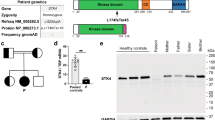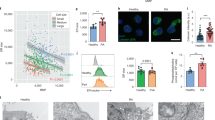Abstract
Aminoacyl-tRNA synthetases (ARSs) are emerging as important regulators in various immune diseases; however, their roles in immune cells remain unclear. In this study, using alanyl-tRNA synthetase (AARS) mutant (sti) mice with neurodegenerative disorder, we investigated the effect of translational fidelity in immune cells. Dysfunctional AARS caused disorders in immune cell responses and cellularity. The impairment was caused by dampened TCR signaling than cytokine signaling. Therefore, sti mutant inhibits TCR signaling, impeding T cell survival and responses. B cell numbers were decreased in sti mice. Despite low B cell cellularity, serum IgM, IgA, and IgE levels were higher in sti mice than in wild-type mice. Misacylation of ARS and the consequent translational infidelity induce disturbances in signaling pathways critical for immune cell survival and responses. Our findings provide a novel mechanism by which translational fidelity might play a critical role in cellular and humoral immune responses.




Similar content being viewed by others
Data availability
All relevant data are within the manuscript and Supplementary Information Appendix.
Code availability
Not applicable.
References
Cusack S (1997) Aminoacyl-tRNA synthetases. Curr Opin Struct Biol 7(6):881–889. https://doi.org/10.1016/s0959-440x(97)80161-3
Schmeing TM, Voorhees RM, Kelley AC, Gao YG, Murphy FV, Weir JR et al (2009) The crystal structure of the ribosome bound to EF-Tu and aminoacyl-tRNA. Science 326(5953):688–694. https://doi.org/10.1126/science.1179700
Pedersen L, Andersen GR, Knudsen CR, Kinzy TG, Nyborg J (2001) Crystallization of the yeast elongation factor complex eEF1A-eEF1B alpha. Acta Crystallogr D Biol Crystallogr 57(Pt 1):159–161. https://doi.org/10.1107/s0907444900015559
Liu B, Conn CS, Qian SB (2012) Viewing folding of nascent polypeptide chains from ribosomes. Expert Rev Proteomics 9(6):579–581. https://doi.org/10.1586/epr.12.57
Walter S, Buchner J (2002) Molecular chaperones–cellular machines for protein folding. Angew Chem Int Ed Engl 41(7):1098–1113. https://doi.org/10.1002/1521-3773(20020402)41:7%3c1098::aid-anie1098%3e3.0.co;2-9
Lin L, Hale SP, Schimmel P (1996) Aminoacylation error correction. Nature 384(6604):33–34. https://doi.org/10.1038/384033b0
Beebe K, Merriman E, Schimmel P (2003) Structure-specific tRNA determinants for editing a mischarged amino acid. J Biol Chem 278(46):45056–45061. https://doi.org/10.1074/jbc.M307080200
Soto C (2003) Unfolding the role of protein misfolding in neurodegenerative diseases. Nat Rev Neurosci 4(1):49–60. https://doi.org/10.1038/nrn1007
Kirchner S, Ignatova Z (2015) Emerging roles of tRNA in adaptive translation, signalling dynamics and disease. Nat Rev Genet 16(2):98–112. https://doi.org/10.1038/nrg3861
Liu Y, Satz JS, Vo MN, Nangle LA, Schimmel P, Ackerman SL (2014) Deficiencies in tRNA synthetase editing activity cause cardioproteinopathy. Proc Natl Acad Sci U S A 111(49):17570–17575. https://doi.org/10.1073/pnas.1420196111
Ahn YH, Park S, Choi JJ, Park BK, Rhee KH, Kang E et al (2016) Secreted tryptophanyl-tRNA synthetase as a primary defence system against infection. Nat Microbiol 2:16191. https://doi.org/10.1038/nmicrobiol.2016.191
Howard OM, Dong HF, Yang D, Raben N, Nagaraju K, Rosen A et al (2002) Histidyl-tRNA synthetase and asparaginyl-tRNA synthetase, autoantigens in myositis, activate chemokine receptors on T lymphocytes and immature dendritic cells. J Exp Med 196(6):781–791. https://doi.org/10.1084/jem.20020186
Zhou JJ, Wang F, Xu Z, Lo WS, Lau CF, Chiang KP et al (2014) Secreted histidyl-tRNA synthetase splice variants elaborate major epitopes for autoantibodies in inflammatory myositis. J Biol Chem 289(28):19269–19275. https://doi.org/10.1074/jbc.C114.571026
Zhu C, Sun B, Nie A, Zhou Z (2020) The tRNA-associated dysregulation in immune responses and immune diseases. Acta Physiol (Oxf) 228(2):e13391. https://doi.org/10.1111/apha.13391
Lee JW, Beebe K, Nangle LA, Jang J, Longo-Guess CM, Cook SA et al (2006) Editing-defective tRNA synthetase causes protein misfolding and neurodegeneration. Nature 443(7107):50–55. https://doi.org/10.1038/nature05096
Kim G, Hwang H, Jo Y, Lee B, Lee YH, Kim CH et al (2018) Soluble γc receptor attenuates anti-tumor responses of CD8(+) T cells in T cell immunotherapy. Int J Cancer 143(5):1212–1223. https://doi.org/10.1002/ijc.31402
Lee B, Jo Y, Kim G, Ali LA, Sohn DH, Lee SG et al (2019) Specific inhibition of soluble γc receptor attenuates collagen-induced arthritis by modulating the inflammatory T cell responses. Front Immunol 10:209. https://doi.org/10.3389/fimmu.2019.00209
Alves NL, Arosa FA, van Lier RA (2007) Common gamma chain cytokines: dissidence in the details. Immunol Lett 108(2):113–120. https://doi.org/10.1016/j.imlet.2006.11.006
Takada K, Jameson SC (2009) Naive T cell homeostasis: from awareness of space to a sense of place. Nat Rev Immunol 9(12):823–832. https://doi.org/10.1038/nri2657
Keller HR, Kim HK, Jo Y, Gress RE, Hong C, Park JH (2020) The abundance and availability of cytokine receptor IL-2Rβ (CD122) constrain the lymphopenia-induced homeostatic proliferation of naive CD4 T cells. J Immunol (Baltimore, Md: 1950) 204(12):3227–3235. https://doi.org/10.4049/jimmunol.1901276
Hong C, Luckey MA, Ligons DL, Waickman AT, Park JY, Kim GY et al (2014) Activated T cells secrete an alternatively spliced form of common γ-chain that inhibits cytokine signaling and exacerbates inflammation. Immunity 40(6):910–923. https://doi.org/10.1016/j.immuni.2014.04.020
Boding L, Bonefeld CM, Nielsen BL, Lauritsen JP, von Essen MR, Hansen AK et al (2009) TCR down-regulation controls T cell homeostasis. J Immunol 183(8):4994–5005. https://doi.org/10.4049/jimmunol.0901539
Surh CD, Sprent J (2008) Homeostasis of naive and memory T cells. Immunity 29(6):848–862. https://doi.org/10.1016/j.immuni.2008.11.002
Aloulou M, Fazilleau N (2019) Regulation of B cell responses by distinct populations of CD4 T cells. Biomed J 42(4):243–251. https://doi.org/10.1016/j.bj.2019.06.002
King C (2009) New insights into the differentiation and function of T follicular helper cells. Nat Rev Immunol 9(11):757–766. https://doi.org/10.1038/nri2644
Dogan SA, Pujol C, Maiti P, Kukat A, Wang S, Hermans S et al (2014) Tissue-specific loss of DARS2 activates stress responses independently of respiratory chain deficiency in the heart. Cell Metab 19(3):458–469. https://doi.org/10.1016/j.cmet.2014.02.004
Hilander T, Zhou XL, Konovalova S, Zhang FP, Euro L, Chilov D et al (2018) Editing activity for eliminating mischarged tRNAs is essential in mammalian mitochondria. Nucleic Acids Res 46(2):849–860. https://doi.org/10.1093/nar/gkx1231
Vo MN, Terrey M, Lee JW, Roy B, Moresco JJ, Sun L et al (2018) ANKRD16 prevents neuron loss caused by an editing-defective tRNA synthetase. Nature 557(7706):510–515. https://doi.org/10.1038/s41586-018-0137-8
Morris R, Kershaw NJ, Babon JJ (2018) The molecular details of cytokine signaling via the JAK/STAT pathway. Protein Sci 27(12):1984–2009. https://doi.org/10.1002/pro.3519
Hwang JR, Byeon Y, Kim D, Park SG (2020) Recent insights of T cell receptor-mediated signaling pathways for T cell activation and development. Exp Mol Med 52(5):750–761. https://doi.org/10.1038/s12276-020-0435-8
Lo WL, Shah NH, Ahsan N, Horkova V, Stepanek O, Salomon AR et al (2018) Lck promotes Zap70-dependent LAT phosphorylation by bridging Zap70 to LAT. Nat Immunol 19(7):733–741. https://doi.org/10.1038/s41590-018-0131-1
Horejsí V, Zhang W, Schraven B (2004) Transmembrane adaptor proteins: organizers of immunoreceptor signalling. Nat Rev Immunol 4(8):603–616. https://doi.org/10.1038/nri1414
Itoh M, Dai H, Horike SI, Gonzalez J, Kitami Y, Meguro-Horike M et al (2019) Biallelic KARS pathogenic variants cause an early-onset progressive leukodystrophy. Brain 142(3):560–573. https://doi.org/10.1093/brain/awz001
Khan WN (2009) B cell receptor and BAFF receptor signaling regulation of B cell homeostasis. J Immunol 183(6):3561–3567. https://doi.org/10.4049/jimmunol.0800933
Calamito M, Juntilla MM, Thomas M, Northrup DL, Rathmell J, Birnbaum MJ et al (2010) Akt1 and Akt2 promote peripheral B-cell maturation and survival. Blood 115(20):4043–4050. https://doi.org/10.1182/blood-2009-09-241638
Kurosaki T, Hikida M (2009) Tyrosine kinases and their substrates in B lymphocytes. Immunol Rev 228(1):132–148. https://doi.org/10.1111/j.1600-065X.2008.00748
Mackay F, Schneider P, Rennert P, Browning J (2003) BAFF and APRIL: a tutorial on B cell survival. Annu Rev Immunol 21:231–264. https://doi.org/10.1146/annurev.immunol.21.120601.141152
Yasuda T, Sanjo H, Pagès G, Kawano Y, Karasuyama H, Pouysségur J et al (2008) Erk kinases link pre-B cell receptor signaling to transcriptional events required for early B cell expansion. Immunity 28(4):499–508. https://doi.org/10.1016/j.immuni.2008.02.015
Moore PA, Belvedere O, Orr A, Pieri K, LaFleur DW, Feng P et al (1999) BLyS: member of the tumor necrosis factor family and B lymphocyte stimulator. Science 285(5425):260–263. https://doi.org/10.1126/science.285.5425.260
Nie A, Sun B, Fu Z, Yu D (2019) Roles of aminoacyl-tRNA synthetases in immune regulation and immune diseases. Cell Death Dis 10(12):901. https://doi.org/10.1038/s41419-019-2145-5
Park SG, Schimmel P, Kim S (2008) Aminoacyl tRNA synthetases and their connections to disease. Proc Natl Acad Sci U S A 105(32):11043–11049. https://doi.org/10.1073/pnas.0802862105
Boguniewicz M, Leung DY (2011) Atopic dermatitis: a disease of altered skin barrier and immune dysregulation. Immunol Rev 242(1):233–246. https://doi.org/10.1111/j.1600-065X.2011.01027.x
Crameri R, Blaser K (2002) Allergy and immunity to fungal infections and colonization. Eur Respir J 19(1):151–157. https://doi.org/10.1183/09031936.02.00229102
Fay NS, Larson EC, Jameson JM (2016) Chronic inflammation and γδ T cells. Front Immunol 7:210. https://doi.org/10.3389/fimmu.2016.00210
Iwamura C, Nakayama T (2010) Role of NKT cells in allergic asthma. Curr Opin Immunol 22(6):807–813. https://doi.org/10.1016/j.coi.2010.10.008
Wilson RP, McGettigan SE, Dang VD, Kumar A, Cancro MP, Nikbakht N et al (2019) IgM plasma cells reside in healthy skin and accumulate with chronic inflammation. J Invest Dermatol 139(12):2477–2487. https://doi.org/10.1016/j.jid.2019.05.009
Sun W, Gudi RR, Johnson BM, Vasu C (2020) Abundance and nuclear antigen reactivity of intestinal and fecal immunoglobulin A in lupus-prone mice at younger ages correlate with the onset of eventual systemic autoimmunity. Sci Rep 10(1):14258. https://doi.org/10.1038/s41598-020-71272-8
Matsumoto M, Ra C, Kawamoto K, Sato H, Itakura A, Sawada J et al (1999) IgE hyperproduction through enhanced tyrosine phosphorylation of Janus kinase 3 in NC/Nga mice, a model for human atopic dermatitis. J Immunol 162(2):1056–1063
Cookson W (2004) The immunogenetics of asthma and eczema: a new focus on the epithelium. Nat Rev Immunol 4(12):978–988. https://doi.org/10.1038/nri1500
Acknowledgements
We thank Dr. Lee at the KRIBB and the members of the Hong lab for critical review of this manuscript. This work was supported by the Medical Research Center Program (2015R1A5A2009656) and Basic Science Research Program (2020R1A2C1006616) through a National Research Foundation of Korea (NRF) funded by the Korean government.
Funding
Funding was provided by the Medical Research Center Program (2015R1A5A2009656) and Basic Science Research Program (2020R1A2C1006616) through a National Research Foundation of Korea (NRF).
Author information
Authors and Affiliations
Contributions
CH conceived and designed the study. JAS, YJ, HH, DL, SEL, DH, JK and CH performed experiments and analyzed data. JAS, YJ, DL, JHL, PS and CH analyzed and interpreted the results. JAS and CH wrote the manuscript. All authors read and approved the manuscript.
Corresponding author
Ethics declarations
Conflict of interest
The authors declare no competing financial interests.
Ethical approval
All the procedures involving animals in this study complied with Pusan National University (PNU) Institutional Animal Care and Use Committee (PNU-2020-2714) and the KRIBB Animal Care and Use Committee (KRIBB-AEC-18156).
Consent for publication
All the authors have approved and agreed to publish this manuscript.
Additional information
Publisher's Note
Springer Nature remains neutral with regard to jurisdictional claims in published maps and institutional affiliations.
Supplementary Information
Below is the link to the electronic supplementary material.
Rights and permissions
About this article
Cite this article
Shim, J.A., Jo, Y., Hwang, H. et al. Defects in aminoacyl-tRNA synthetase cause partial B and T cell immunodeficiency. Cell. Mol. Life Sci. 79, 87 (2022). https://doi.org/10.1007/s00018-021-04122-z
Received:
Revised:
Accepted:
Published:
DOI: https://doi.org/10.1007/s00018-021-04122-z




